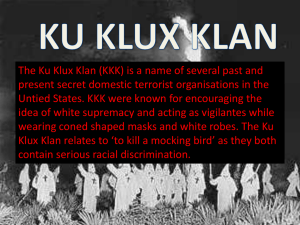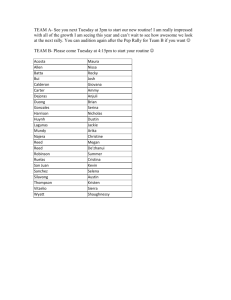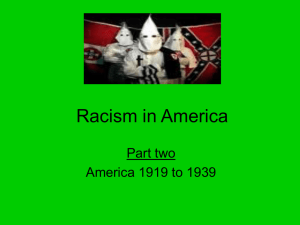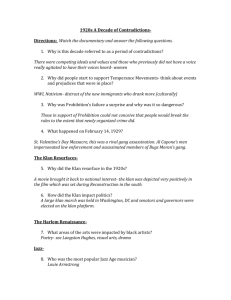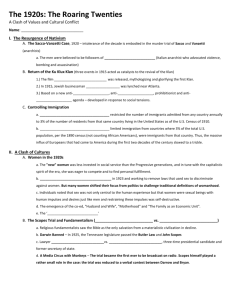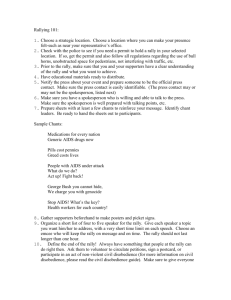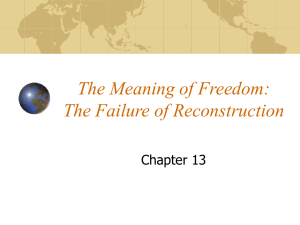Teacher`s Guide - Duke University School of Law
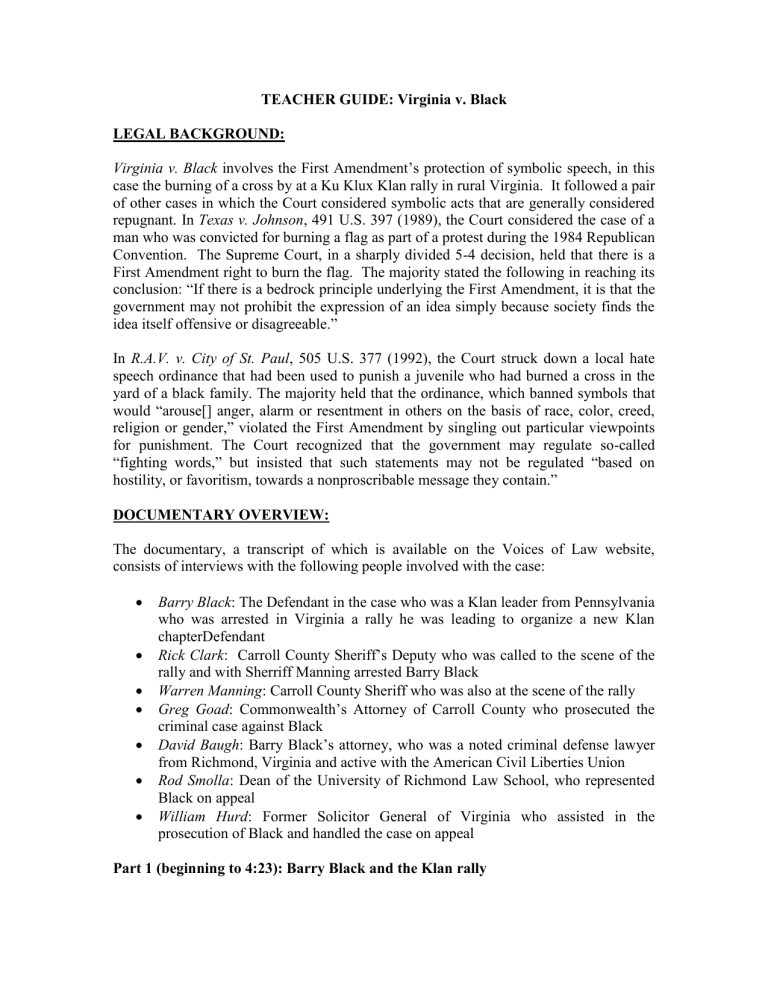
TEACHER GUIDE: Virginia v. Black
LEGAL BACKGROUND:
Virginia v. Black involves the First Amendment’s protection of symbolic speech, in this case the burning of a cross by at a Ku Klux Klan rally in rural Virginia. It followed a pair of other cases in which the Court considered symbolic acts that are generally considered repugnant. In Texas v. Johnson , 491 U.S. 397 (1989), the Court considered the case of a man who was convicted for burning a flag as part of a protest during the 1984 Republican
Convention. The Supreme Court, in a sharply divided 5-4 decision, held that there is a
First Amendment right to burn the flag. The majority stated the following in reaching its conclusion: “If there is a bedrock principle underlying the First Amendment, it is that the government may not prohibit the expression of an idea simply because society finds the idea itself offensive or disagreeable.”
In R.A.V. v. City of St. Paul , 505 U.S. 377 (1992), the Court struck down a local hate speech ordinance that had been used to punish a juvenile who had burned a cross in the yard of a black family. The majority held that the ordinance, which banned symbols that would “arouse[] anger, alarm or resentment in others on the basis of race, color, creed, religion or gender,” violated the First Amendment by singling out particular viewpoints for punishment. The Court recognized that the government may regulate so-called
“fighting words,” but insisted that such statements may not be regulated “based on hostility, or favoritism, towards a nonproscribable message they contain.”
DOCUMENTARY OVERVIEW:
The documentary, a transcript of which is available on the Voices of Law website, consists of interviews with the following people involved with the case:
Barry Black : The Defendant in the case who was a Klan leader from Pennsylvania who was arrested in Virginia a rally he was leading to organize a new Klan chapterDefendant
Rick Clark
: Carroll County Sheriff’s Deputy who was called to the scene of the rally and with Sherriff Manning arrested Barry Black
Warren Manning : Carroll County Sheriff who was also at the scene of the rally
Greg Goad :
Commonwealth’s Attorney of Carroll County who prosecuted the criminal case against Black
David Baugh : Barry Black’s attorney, who was a noted criminal defense lawyer from Richmond, Virginia and active with the American Civil Liberties Union
Rod Smolla : Dean of the University of Richmond Law School, who represented
Black on appeal
William Hurd : Former Solicitor General of Virginia who assisted in the prosecution of Black and handled the case on appeal
Part 1 (beginning to 4:23): Barry Black and the Klan rally
Barry Black explains the Klan rally and cross lighting ceremony that he led in Carroll
County, and officers Manning and Clark describe their impressions of it.
Part 2 (4:23 to 8:24): Black’s arrest and search for a lawyer
Manning and Clark react to the sight of the burning cross. Clark recalls that cross burning is a crime in Virginia, and Manning arrests Black. Unable to find a local lawyer, Black contacts the Virginia ACLU; African-American attorney David Baugh agrees to handle the case. Black and Baugh describe their reactions to each other.
Part 3 (8:24 to 14:48): The trial
William Hurd explains the historical context of the statute banning cross burning; Baugh and Rod Smolla argue that the act of burning a cross is symbolic speech that cannot be banned under the First Amendment unless it is done for the purpose of intimidation.
Clark and Goad describe the testimony of one of the witnesses to the Klan rally who said she felt intimidated, though Baugh argues that the rally and the burning cross were not meant to intimidate anyone in particular. Black is convicted and fined $2,500.
Part 4 (14:48 to the end): The appeals
On appeal to the Virginia Supreme Court, Black’s case is consolidated with another cross-burning case from Virginia Beach. That court reverses the convictions, and
Virginia petitions the U.S. Supreme Court for review. Hurd and Smolla elucidate their arguments, and Smolla describes Justice Thomas’s uncharacteristically passionate questioning at oral argument.
SUGGESTED APPROACHES TO USING THE DOCUMENTARY:
Two simple approaches to using the documentary are to show the entire case video in class or to assign students to watch it outside of class. The documentary concludes when the Supreme Court grants review, leaving discussion of the Court’s opinion for the classroom; we have found that the documentary is most effective when viewed before reading the opinion, because students are better prepared to analyze and discuss the factual setting and the legal issues in the case when they have heard from the parties involved.
Professors may also consider showing discrete sections of the video in class. For example, showing Part 1 or Part 2 in class – or both – establishes the factual context, including a compelling verbal and visual illustration of the Klan rally and cross burning in part 1 and an intriguing glimpse into the unusual lawyer/client relationship of Baugh and Black. Few students will have any real association with what a Klan rally might entail. It is also useful for students to hear Barry Black discuss his views. The documentary includes some actual footage from a Klan rally that Black led a few months prior to the Virginia rally (there was no video of the Virginia rally). Showing these two
Parts present all the ironies of the case (Northern Klan member being represented by an
African-American lawyer being arrested by white officers from the South who are deeply offended by the Klan’s presence in their community).
Part 3 covers the initial phases of the case and the trial, and can help inform the discussion of the legal issues ultimately considered by the Supreme Court. Part 4 may be shown on its own to flesh out the legal issues and reveal both the lawyers’ strategies in developing their arguments and the judges’ reactions to those arguments.
The case video is accompanied by two different party narratives. The first tells the story of the case from the perspective of Barry Black. The party effectively illustrates the views and experiences of this most unusual defendant as he interacts with the legal system from his arrest to his learning of the Supreme Court’s decision. Hearing his views expressed at greater length than in the case video can provide a point of departure for students to debate whether the First Amendment should protect such views.
A second party narrative presents the story of David Baugh and his career as a criminal defense attorney in Richmond. His is an interesting story and his decision as an African-
American attorney to represent Klan leader Barry Black raises important ethical issues.
(Indeed, this party narrative could be used in a course on legal ethics for discussing the responsibilities of attorneys for representing unpopular clients).
